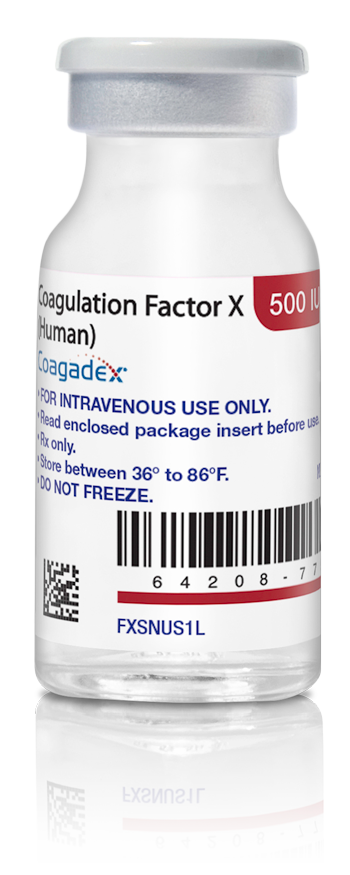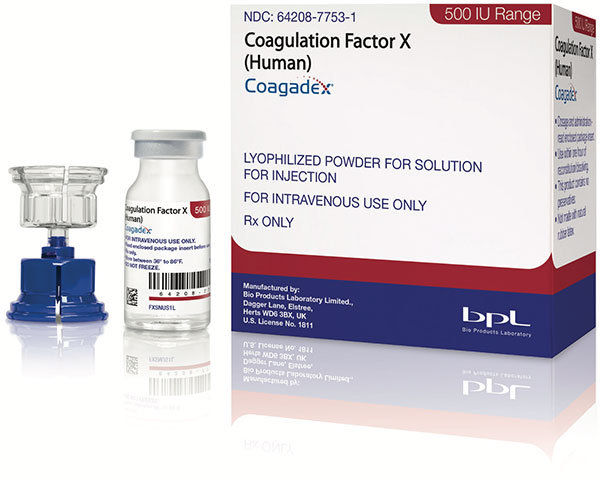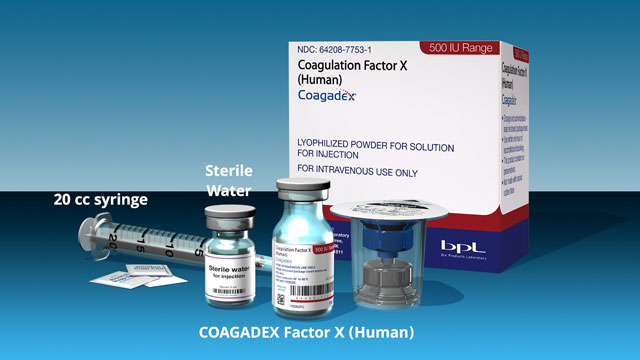COAGADEX Is the First and Only Approved Treatment Developed to Replace Exactly What These Patients Are Missing—Factor X
Factor content of COAGADEX1


No Other Product is Based on a Factor X Assay2
Factor Content of Selected Factor X-Containing PCC Products1,3
IU of Factors X, IX, VII, and II Relative to 100 IU of Reference Assay Factor*
Kcentra®
(PCC)
(PCC)

Profilnine SD®
(PCC)
(PCC)

*COAGADEX is manufactured using factor X as the reference assay factor. Kcentra and Profilnine SD are manufactured using factor IX as the reference assay factor; data are from testing of specific batches at the time the article was written.
Elevated levels of factors II, VII, and IX in the blood may be associated with an increased risk of thromboembolic complications4
Other risk factors that can contribute to thrombotic risk include:
- Older age
- Traumatic injury
- Surgical intervention
- Pregnancy
Pharmacokinetics of COAGADEX Support Twice-Weekly Dosing for Prophylaxis2
Factor X Activity Levels Following Single-Dose COAGADEX Administration6

A prospective, non-comparative, multicenter phase III COAGADEX pharmacokinetics (PK) study analyzing plasma factor X activity after a single 25 IU/kg bolus dose at baseline and after ≥6 months of on-demand treatment, in 10 females and 6 male subjects (n=16) aged 12–58 years with moderate or severe hereditary factor X deficiency. At each PK assessment, blood samples were taken pre-dose and at intervals of up to 144 hours post-dose.
For prophylaxis
- Adjust dosage to clinical response and trough FX levels of at least 5 IU/dL2
- Continue adjustment as needed to maintain FX levels appropriate for the patient and clinical response2
- Treatment of hereditary factor X deficiency has evolved over time. As of 2021, as noted in Tarantino et al, “the goal is to return trough FX to 10–20% [IU/dL], ideally increasing FX to >40% [IU/dL], at which point patients are usually asymptomatic”9
For infants and children age 0 to <12 years7,8
- Mean incremental recovery is lower for infants and children age 0 to <12 years, requiring higher doses of COAGADEX (as noted in the Dosing Instructions)
- As with any patient receiving COAGADEX, adjust dosage to clinical response and trough FX levels of at least 5 IU/dL
COAGADEX Dosing Instructions2
- Dose and duration of treatment depend on the severity of the factor X deficiency, location and extent of bleeding, and the patient’s clinical condition
- Base dose and frequency on individual clinical response. Do not administer more than 60 IU/kg daily.
 For prophylaxis of bleeding episodes
For prophylaxis of bleeding episodes
| Age | Initial Dose | Further Management |
|---|---|---|
| 0 to <12 years | 40 IU/kg twice weekly | Monitor trough blood levels of factor X targeting at least 5 IU/dL and adjust dosage to clinical response and trough levels. Do not exceed a peak level of 120 IU/dL |
| ≥12 years | 25 IU/kg twice weekly |
 For on-demand treatment of bleeding episodes
For on-demand treatment of bleeding episodes
| Age | Initial Dose | Further Management |
|---|---|---|
| 0 to <12 years | 30 IU/kg | Infuse at first sign of bleeding. Repeat at intervals of 24 hours until the bleed stops |
| ≥12 years | 25 IU/kg |
 For perioperative management
For perioperative management
| Age | Initial Dose | Further Management |
|---|---|---|
| 0 to <12 years | Use a factor of 0.6 to calculate the required dose | Pre-surgery: raise plasma factor X levels to 70-90 IU/dL Post-surgery: maintain plasma factor X levels at ≥50 IU/dL until the patient is no longer at risk of bleeding due to surgery |
| Dose (IU) = body weight (kg) x desired factor X rise* (IU/dL or % of normal) x 0.6 | ||
| ≥12 years | Use a factor of 0.5 to calculate the required dose | Pre-surgery: raise plasma factor X levels to 70-90 IU/dL Post-surgery: maintain plasma factor X levels at ≥50 IU/dL until the patient is no longer at risk of bleeding due to surgery |
| Dose (IU) = body weight (kg) x desired factor X rise* (IU/dL or % of normal) x 0.5 | ||
*The desired factor X rise is the difference between the patient’s plasma factor X level and the maximum desired level.
Storage and Supply Information
- Store COAGADEX in a refrigerator or at room temperature at 36° to 86º Fahrenheit (2° to 30° Celsius)
- Do not freeze
- Single-use vial sizes
- 250 IU with 2.5 mL sterile water (NDC 64208-7752-1)
- 500 IU with 5.0 mL sterile water (NDC 64208-7753-1)
- Mix2Vial® in each box for reconstitution*

*Mix2Vial is a registered trademark of West Pharmaceutical Services.
COAGADEX Reconstitution Instructions
References: 1. Data on file, BPL-RD050-0515. 2. COAGADEX® (Coagulation Factor X, Human) Prescribing Information. Durham, NC: BPL Limited. 2023. 3. Sorenson B, Spahn DR, Innerhofer P, et al. Crit Care. 2011;15:201. 4. Menegatti M, Peyvandi F. Semin Thromb Hemost. 2009;35:407-415. 5. Medical and Scientific Advisory Council (MASAC) of the National Hemophilia Foundation. MASAC Document #276. https://www.hemophilia.org/healthcare-professionals/guidelines-on-care/masac-documents/masac-document-276-masac-recommendations-concerning-products-licensed-for-the-treatment-of-hemophilia-and-selected-disorders-of-the-coagulation-system. Accessed May 31, 2023. 6. Austin SK, et al. Haemophilia. 2016;22:426-432. 7. Liesner R, et al. Haemophilia. 2018;941–949. 8. Zimowski KL, et al. J Thromb Haemost. 2020;18:2551–2556. 9. Tarantino MD. Haemophilia. 2021;27(4):531-543. doi: 10.1111/hae.14223.


Indications and Usage for COAGADEX
COAGADEX, a plasma-derived blood coagulation factor X concentrate, is indicated in adults and children with hereditary factor X deficiency for:
- Routine prophylaxis to reduce the frequency of bleeding episodes
- On-demand treatment and control of bleeding episodes
- Perioperative management of bleeding in patients with mild, moderate and severe hereditary factor X deficiency
Contraindication for COAGADEX
COAGADEX is contraindicated in patients who have had life-threatening hypersensitivity reactions to COAGADEX.
Important Safety Information for COAGADEX
Allergic type hypersensitivity reactions, including anaphylaxis, are possible with COAGADEX. If symptoms occur, patients should discontinue use of the product immediately, contact their physician, and administer appropriate treatment.
The formation of neutralizing antibodies (inhibitors) to factor X is a possible complication in the management of individuals with factor X deficiency. Carefully monitor patients taking COAGADEX for the development of inhibitors by appropriate clinical observations and laboratory tests.
COAGADEX is made from human plasma and may contain infectious agents, e.g. viruses, the variant Creutzfeldt-Jakob disease (vCJD) agent and, theoretically, the Creutzfeldt-Jakob disease (CJD) agent. No cases of transmission of viral diseases, vCJD or CJD, have been associated with the use of COAGADEX.
In clinical studies, the most common adverse reactions (frequency ≥5% of subjects) with COAGADEX were infusion site erythema, infusion site pain, fatigue and back pain.
